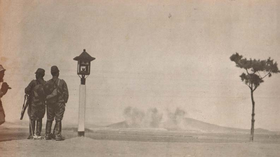Unhak Campaign
| Unhak Campaign | ||||||||||
|---|---|---|---|---|---|---|---|---|---|---|
 Hoterallian soldiers watching artillery fires on Mount Shinonome, 1847 | ||||||||||
| ||||||||||
| Belligerents | ||||||||||
|
|
|
| ||||||||
| Commanders and leaders | ||||||||||
|
| TBA | TBA | ||||||||
| Strength | ||||||||||
|
17,000, rising to 58,000 by October 1849 Around a dozen warships | TBA | TBA | ||||||||
| Casualties and losses | ||||||||||
|
Killed: 34,076 Wounded: Over 20,000 Died from disease: 3,889 | TBA | TBA | ||||||||
The Unhak Campaign (Hoterallian: 運発戦線) was a conflict between the Empire of Hoterallia and the armed forces of the short-lived Republic of Santa Cruz, and later the Riamese Empire. The Hoterallians sought to take control of the weakening territories in the Unhakken Archipelago, while the Republican forces fought to resist the Hoterallian occupation. The Hoterallian landed near modern-day Aniki on the southern coast of the archipelago on 16 September 1838, and in a 9-years campaign swept northwards. Although their advance was slowed by guerrilla activity, the Hoterallians defeated the Republican forces (a mixture of regular native units and Gavrilian militias) whenever they attempted to make a stand. The Hoterallian victory at Bokugyo on 27 August 1841 became the turning point in the war as it doomed the native and Gavrilian resistance to an early defeat. The fall of Bokugyo was followed by a naval invasion by the Riamese Empire in an attempt to capitulate the already weakened Hoterallian forces. The invasion kickstarted another period of conflicts in the Archipelago, lasting for another two decades of grueling warfare. In mid-1859, the number of Riameses began to decrease before the last of the Riamese forces surrendered on the 21st of October.[1]
References
- ↑ Takekoshi, Yosaburō (1976). Hoterallian rule in Unhak. Guri: University of Guri Press